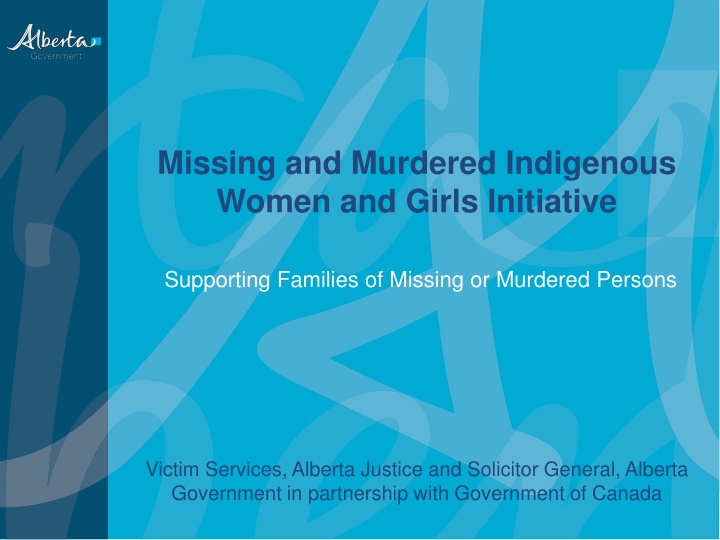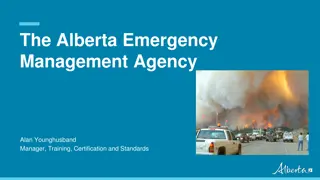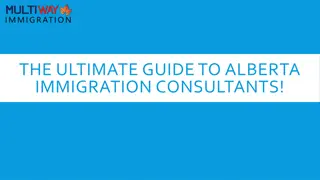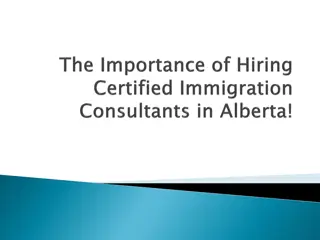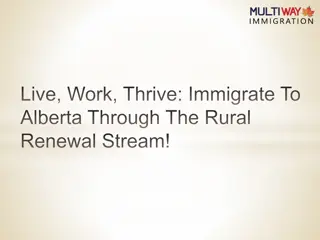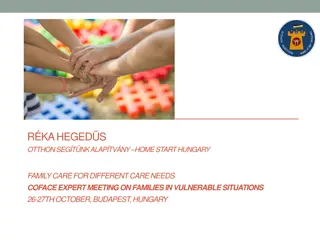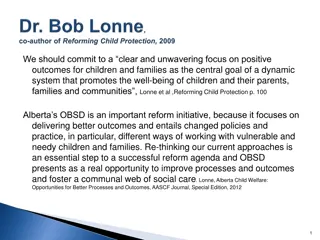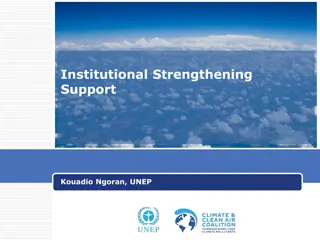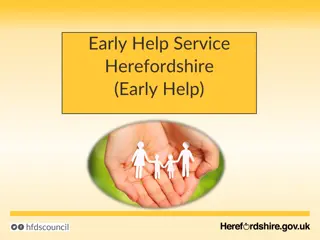Supporting Families: Alberta's MMIW Initiative
The Missing and Murdered Indigenous Women and Girls (MMIW) Initiative in Alberta, supported by Victim Services, aims to engage Indigenous communities, identify system gaps, and advance recommendations to address the issue. Efforts include hiring specialists, awareness campaigns, and police advisory committees to improve responses and legislation for missing persons and homicides. Challenges like fear of reporting, police assumptions, and historical impacts are being addressed through community engagements and policy changes.
Download Presentation

Please find below an Image/Link to download the presentation.
The content on the website is provided AS IS for your information and personal use only. It may not be sold, licensed, or shared on other websites without obtaining consent from the author.If you encounter any issues during the download, it is possible that the publisher has removed the file from their server.
You are allowed to download the files provided on this website for personal or commercial use, subject to the condition that they are used lawfully. All files are the property of their respective owners.
The content on the website is provided AS IS for your information and personal use only. It may not be sold, licensed, or shared on other websites without obtaining consent from the author.
E N D
Presentation Transcript
Missing and Murdered Indigenous Women and Girls Initiative Supporting Families of Missing or Murdered Persons Victim Services, Alberta Justice and Solicitor General, Alberta Government in partnership with Government of Canada
One woman goes missing, then another, then another. For a long time only those who know and love them pay attention. Until the numbers start to add up. Finding Dawn 2
Albertas MMIW Initiative Purpose Engage Indigenous communities Examine resources, policies and practices Identify system gaps and needs Look at geographical considerations Survey victim services, police services and community organizations Identify and advance recommendations 3
Whats Being Done Two positions have been hired to ensure recommendations are implemented Provincial homicide family liaison Provincial missing person coordinator Shared findings to increase awareness Presentations throughout the province to police, victim services, support agencies, court services, communities Missing persons awareness campaign Address myths around missing persons Distributed to over 2000 people 5
What We Heard: Police Response Long response times in some remote communities Fear of retribution and lack of anonymous reporting Feel the police had pre-conceived assumptions about complaints from an Indigenous person. Fear of police response to a report of violence or a missing person, especially if removal of a loved one Perception that police only show up when there s trouble Perception that most police do not understand the historical impacts and the personal (community) history of the people Experience police not taking missing persons reports 6
Whats Being Done Police Advisory Committee on Missing Persons Representatives from each police force and victims services across Alberta Ensure services provided to families of missing people are robust, appropriate and culturally safe Legislation Changes Amend Missing Persons Act to ensure police have authority to locate missing person in a timely manner Changes currently awaiting legislative approval Referral process A review of the referral process from police services to victim services for missing persons and homicide is underway. This will guide a standard policy between police and victims services for missing persons and homicide 7
What We Heard: Victims Services There are not enough Indigenous victims advocates Missing persons is not within Victims Services scope Underservice youth Limited resources for complex needs High turnover of staff and volunteerism is tricky Lack of funding for counselling for families of missing and murdered Financial Benefits are dependent on criminal history of victim Concerns about privacy and anonymity Lack of awareness of victims services Lack of consistent practice across the province 8
Whats Being Done Family information liaison unit All Indigenous staff Work directly with families of missing or murdered Indigenous women and girls Help families navigate government systems to obtain information from police, courts, child services, medical examiner and other agencies Provide culturally safe emotional support and ceremonial opportunities for the family Regionalized travel into the remote communities of the province to provide supports to families who do not have access to the urban centers 9
Indigenous Victims Outreach Specialists (IVOS) Targeted outreach initiative Goal is to have a consistent Victims Services in community to build trust, increase indigenous access to services and provide culturally safe practice First two positions were created in 2007, a third added in 2011 We now have eight IVOS positions throughout the province 10
Funding Victims Services is currently conducting a review of the Victims of Crime legislation and funding process which will affect services and funding for families Recent announcements were made announcing increased funding for the busiest Victims Service Units This includes a further $1,000,000 for the Indigenous Victims Outreach Healing gathering for families To bring families together in a safe place where they can share what is helpful and meaningful for them in understanding the loss of their loved one Creation of ambiguous loss training Ambiguous Loss is a type of grief that is different from other types of grief. We are working to develop training for all provincial partners who support the families of missing persons 11
Missing persons peer support groups coordinating with community partners and loved ones of missing persons to establish missing persons peer support groups Professional Guides Developing guides to assist victims services in supporting families of the missing and murdered Working to include information on youth and complex needs Working with Alberta Health Services to develop ambiguous loss training 12
What We Heard: Cultural Safety In your opinion, how important is it to have services that are culturally sensitive and/or relevant available to Indigenous victims of crime? 1 N/A 7 Unsure 137 Very important Yes, it is important 45 Somewhat important 5 3 Not at all 0 20 40 60 80 100 120 140 160 13
14 Jessica Ball, M.P.H., Ph.D. Cultural Safety in Practice and With Children, Families and Communities, University of Victoria
What is Being Done: Cultural Safety Training Presentations to Victims Services staff and volunteers across the province to ensure culturally safe service delivery Created mandatory on-line training for all Victims Service Continue to work with the police to ensure they are aware of issues identified in the report and their behaviour is culturally safe Work is currently underway to expand cultural safety training to include Alberta Crown Prosecution Services, Court Services, and police services throughout the provinces. 15
Increased Focus on Safety and Prevention Safer Communities Initiative A partnership was developed with non-profit and private sector to offer an easy-to-use phone app to help protectvulnerable people. 16
Safer Communities Initiative 17
Who Can Benefit from the Program? Any individual who may be at risk for violence for any reason: Walking alone Domestic Violence Hitch-hiking Sex work Any other risk Any support agency staff who work remotely, travel, perform outreach or conduct home visits Anyone with an android or Apple smartphone with data or wifi 18
A Little About the Program: It s a phone app that provides emergency back-up to individuals at risk for any reason It connects the client to a response centre, staffed by indigenous women from the Gitxsan nation in real time GPS locations are sent every 5 minutes when a client is logged in The client location is only available when they log in they choose when to connect All information is protected and kept private unless an emergency response is necessary then the GPS location and any entered notes/images are shared for emergency response Offers a connection to a support network who can follow up with the client should an emergency occur There is no cost to any client or support agency 19
Three Main Components Countdown timer When risk is moderate Hazard timer When risk is increased Can be set from 10 minutes to 2 hours by the client Emergency button Immediate notification to to emergency services
What If They Dont Check In? The client will be notified through the app before their safety timer expires. If they do not check in before it does: At check in time: a text will be sent to the client asking them to check in and 15 minutes grace period given At 15 minutes: they will be called and a second text sent At 20 minutes: they will be called a second time. If they do not answer, their emergency contact will be called At 25 minutes: they and their emergency contact will be called again At 30 minutes: the police will be called and notified of their last known whereabouts and asked to respond. The assigned agency is notified to follow up for any necessary aftercare 21
What Information is Needed to Get Started? First and Last name Cell Phone Number Email address Email the above information to: Lisa.Graham@gov.ab.ca or Safercommunities@Ignitech.org The client will receive a confirmation email with directions on creating a password 22
